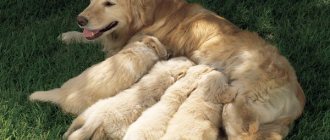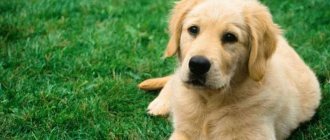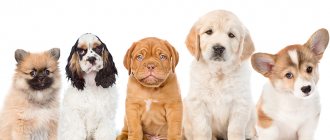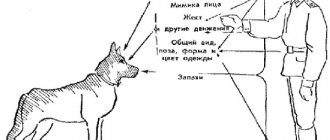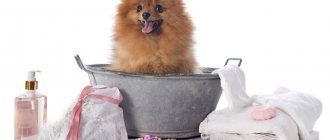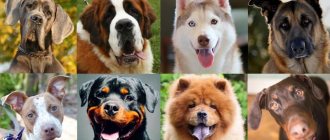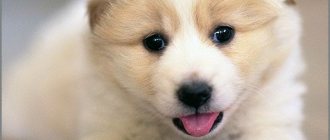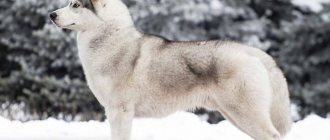How?
A few rules to follow to bathe your puppy correctly:
- When bathing, it is necessary to avoid contact of detergents with the mucous membranes of the nose and mouth.
- Avoid getting water into your eyes and ears.
- Wash gently and thoroughly
- Prepare two towels in advance: with one you can collect the main moisture from the wool, with the second you can wipe and dry
- Place a mat on the bottom of the bathtub to prevent paws from slipping and bathing to be less intimidating.
- The room should be warm, without drafts.
- Start using your blow dryer right away. The puppy will quickly get used to the noise and will not be afraid.
- You can give a treat during bath time. This will brighten up the fears that arise, and pleasant memories will remain.
- Talk to your baby while bathing. The gentle notes of your voice will give him confidence and calm him down.
For the first time
- Prepare a container for bathing. Place a rug on the bottom to prevent your puppy's paws from slipping.
- First, wet the wool well. Apply evenly, avoiding dry areas. To prevent water from getting into the eyes and ears, place your palm on the puppy's head and lightly press the ears toward the head with your fingers. Pour water from above.
- Lightly lather the shampoo and then apply to the coat. Wash thoroughly and gently.
- Rinse off with running water. You heard the creaking of fur - you did it, the puppy is clean.
- Dry the puppy with the first towel.
- In the second, dry his fur if you do not use a hairdryer.
CAUTION : After vaccination, the animal is weakened.
You can swim no earlier than after 2 weeks. If you need to bathe your puppy, do it in a warm room and stay there until the fur is completely dry.
Summing up
A dog’s attitude towards water largely depends on its owner, who introduces the pet to it. The question of how to bathe a puppy is not complicated if the habituation takes place taking into account all the rules and recommendations. Otherwise, the dog may develop severe hydrophobia, and all procedures with water will be accompanied by panic.
At what age can you bathe a puppy? The optimal age is 4 months. Sometimes the first water procedure takes place earlier, since dog breeders wash young animals before selling.
When is it possible?
When you can start washing your pet depends on the age at which water procedures are indicated for the new resident of your apartment. Consider the option of placing a pet in an apartment. What matters is the conditions in which man’s best friend spent his first days of life.
- You have brought a puppy from a breeder: the puppy is already 3 months old and has received the necessary vaccinations. Can be washed from day one. After a walk, be sure to wash your paws. In dirty weather, wash your paws with paw shampoo.
- You found a puppy on the street: you need to wash the puppy, regardless of its age. You may need flea control. With all the possible consequences of untimely washing, it is more useful to be clean.
- You are raising a puppy without a mother dog: you already provide water treatments for your pet when you wipe it with a damp cloth every day. Unless absolutely necessary, such a puppy does not need a shower.
So when to start? Guided by common sense, it is necessary to accustom small household members to bathing from an early age. Specialists do this after vaccinations have been administered.
For the first time
Ideally, you can start bathing your baby for the first time only 2 weeks after vaccinations. In general, the puppy should not smell unpleasant. Males begin to smell stronger at the time of puberty, and females before and during estrus.
If your puppy still has a dog smell even after bathing, then you are probably bathing him too often and this is disrupting the functioning of the sebaceous glands ! The smell of a dog is the smell of fat lubricating the fur, so when the dog is washed, it begins to smell stronger because the fat begins to be released more intensely.
There is no need to wash the puppies immediately after birth: the mother dog can handle this perfectly! And in general, while living with their mother, bathing puppies will be unnecessary and even harmful.
If there is no mother and the puppy is very small, then adhere to the following rule: bathing is possible no earlier than the puppy opens his eyes (2-3 weeks after birth) and only if you found him in absolutely terrible conditions and he is really dirty — dirty with dirt, excrement, fleas/larvae, i.e. a condition that cannot be corrected with wet wipes. In addition, the puppy will need to be wrapped tightly in a thick, dry towel to avoid hypothermia and warmed on your chest .
From what age?
1, 1.5 and 2 months
Many people are interested in how many months can a dog be bathed. It is generally not advisable to wash puppies until they are two months old. That is, you cannot bathe a one-month-old puppy! Veterinarians are inclined to believe that puppies need to be taught to bathe from an early age, starting at six months . The minimum age at which months you can wash without indications for this is 3 months . Remember that it is better not to buy a dog before this age!
Ideally, the breeder should always bathe the puppy before handing it over to the buyer and instruct it for the future . Because a bath on the first day in a new home is a huge stress for a dog child, and the buyer most likely does not have any skills in caring for a puppy.
How to choose a puppy: important tips for a future dog owner. Everyone needs to know this!
Before and after the first vaccination
When you can: before - the dog cannot be washed for 2-3 days, after vaccination - 2 weeks, otherwise there may be complications.
Optimal age and frequency of bathing
When can you bathe a puppy for the first time? They are washed when they reach 4 months of age, but sometimes earlier. The procedure is carried out no more than once a month. Sometimes the baby is washed when it gets dirty or for medical reasons. You can also find out how often you can bathe your puppy by consulting a veterinarian.
In some cases, swimming is prohibited. These include:
- the first 2 weeks after vaccination;
- during illness;
- with a weak immune system;
- if your skin is too sensitive;
- before going for a walk in bad weather.
You should always remember that water washes away sebum from your pet’s skin, protecting it from heavy rains. A minimal amount of sebum will make your dog more susceptible to colds.
The number of baths is reduced if the dog develops skin irritation. It is characterized by profuse dandruff all over the body.
How often?
The issue of frequency of washing a puppy is decided individually by each dog owner. To make a decision, you will have to take into account not only your own capabilities and desires, but also a number of other factors:
- conditions for keeping a pet;
- the breed of your puppy;
- presence of allergies in family members;
- pet's skin condition.
Let's start with the fact that most dogs enjoy bathing. Splashing water makes your friend as happy as it does you. The dog plays with streams of water, catches iridescent water balls, moves actively and, inspired by your joy, invents new ways to catch the running water.
So how often should you bathe? Guided by common sense, it is necessary to accustom small household members to bathing from an early age. Specialists do this after vaccinations have been administered.
Until this time, it is recommended to only wash puppies of all breeds, and not bathe them completely. You can wash it once every 3-4 months. Of course, if they are spoiled like piglets while eating delicious food, then it is not forbidden to wash them, but it is important not to use shampoo or soap more than once every 1-2 months ! You can also accustom your dog to daily care - wiping it with a damp cloth (for example, bearded or “folded” dogs: Shih Tzu, Pug, Shar Pei): most importantly, do not forget to wipe it dry after this procedure!
Remember: A clean dog feels happy and makes its owner's life happy.
Depending on the breed
Experts insist that coat care differs for different breeds of dogs.
| Breed | Is it possible, how and how often |
York | For such a small dog, bathing can be stressful, so don't bathe your Yorkie frequently. Take your time and let the puppy get used to you and the new home. For up to 2 months, try to get by with wet wipes. From 2 months of age, your Yorkie (Yorkshire terrier) can be bathed once every two weeks. Even if the puppy is clean, he will get used to the procedure. Water +38°. No draft. Wash quickly to prevent your puppy from catching a cold. From 5 months, you can bathe once a week; in addition to shampooing, you should add the use of conditioner. |
Labrador | From 2 months you can bathe a Labrador puppy, or rather, give him the opportunity to splash around. The peculiarity of the breed is that it is difficult to damage the fur. Thick undercoat and skin covered with fat from the sebaceous glands allow them to stay warm and not get wet when hunting in lakes. Washing with cold water without shampoo slows down hair loss and growth; washing with warm water, on the contrary, speeds up the change. Shampooing is recommended 2-3 times a year. In this case, you should use shampoo specifically for this breed. Shampoos, by the way, are produced for each color of this breed. There are three of them. Pay special attention to rinsing off the shampoo. Don't skimp on water. |
Dachshund | Be careful with the water pressure . The best temperature is +35 degrees. When bathing your dachshund, start from the tail. Do not limit your movements, let you look around and get used to the new. Be attentive to the puppy, note his reactions. Do everything with confidence and care. |
Shar Pei | It is recommended to wash no more than 2 times a year. Considering that Shar Peis are allergic, you should choose your shampoo very carefully.. Experts recommend products containing sulfur. Yves Saint Bernard, 8 in 1 and Hartz shampoos have proven themselves well. Pay special attention to rinsing off the shampoo . The Shar Pei's skin is very sensitive, and any remaining product can cause itching. The presence of folds obliges the owner to take especially careful care of the skin and fur of their pet. |
Chihuahua | The first bath should be scheduled no earlier than the puppy is 3 months old. The best time for swimming is in the evening, after all the walking. If you bathe earlier, you can go outside no earlier than three hours later. The first time, do not immediately put the puppy in a bowl of water, let him look around, get used to it, and only then pour some water with a ladle or shower head. The optimal water temperature is 35-40 degrees. You cannot rub the skin and fur of such a puppy with a towel. Without allowing it to dry completely, the coat should be combed with a suitable brush. |
Toy Terrier | Veterinarians and breeders agree that it is optimal to wash a toy terrier once every 5-7 months . The most comfortable temperature for a puppy will be +40 degrees. Frequent bathing strips the coat of its natural protective covering and it becomes brittle. After a walk, just rinse your paws and belly with water without using shampoo. It is recommended to dry the coat with a towel or hairdryer. |
Spitz | Use the rain setting on your shower head to bathe your Pomeranian puppy.. Wet the fur carefully from the middle of the body to the head. Pour water over the head after covering it with your palm and pressing the puppy's ears to the head. You can insert cotton swabs into your ears to keep water out. Rinse off the shampoo thoroughly using top-to-bottom movements. After removing excess moisture with a towel, dry the puppy with a hairdryer. It should be noted that a Spitz’s clean coat grows faster than a dirty one, but you should not bathe a Spitz often as it can ruin the coat. After bathing, praise the puppy and give him a treat. |
German Shepherd | You should not wash your puppy unless absolutely necessary. The recommended age to start washing is 3 months. Until this moment, it is better to use a damp cloth to wipe the baby. Let your puppy get used to the bathroom first. Prepare water whose temperature is not higher than 36 degrees. Be prepared for the puppy to shake off any remaining water after bathing - wear an apron. |
Pug | Pugs get cold easily, so for up to 1.5 months it is better to avoid even bathing with plain water. You should bathe your pug as needed to eliminate unpleasant odors. Remember: your male pug smells stronger the more often you bathe him. Washing is recommended after 2.5 months of life. Washing frequency – once every 3 months. Before the procedures, it is advisable to put oil-based eye drops and put cotton swabs in your ears . After bathing, the ears and folds on the face are very carefully and thoroughly wiped with a cotton swab, ensuring dryness. To care for the coat, experts recommend using a brush and cloth. Pug eyes require the following care: wipe the eyes weekly, first with a cotton swab dipped in warm boiled water, then with a dry cotton swab. Instead of water, you can use a decoction of calendula or chamomile. |
Spaniel | To keep such a puppy's coat clean, it is enough to brush him daily. Heavy dirt can be removed with a damp terry cloth and brushed. The coat of these dogs becomes dull from frequent bathing and shampooing. Up to 6 months, it is better to use a self-prepared mixture to wash a puppy: 1 glass of kefir, 1 yolk, ½ glass of warm water. |
Husky | If the dog is not a show dog, forget about bathing representatives of this breed . The best bath for a husky is a snowdrift. It is advisable to bathe Huskies during the shedding season in spring and autumn. Before bathing, you should thoroughly comb your dog. After bathing during the molting period, you can leave your pet in a warm robe for an hour - this will help the fur fall out faster. If this is not required, dry with a hairdryer at the lowest power level. |
Breed characteristics
Some breeds naturally love water and bathing is no problem for them. These include Newfoundland, poodle, retrievers, spaniels and others. The lack of fear of bodies of water is explained by their purpose - dogs were specially bred to work on water.
Since the Yorkshire Terrier is one of the most popular breeds of our time, the question often arises of how to bathe a Yorkie puppy. It is very important to accustom your pet to hygiene procedures even in puppyhood. In the future, this will be carried out by dog groomers. As a rule, the baby is washed for the first time by the breeder himself before being sold. Therefore, it is not advisable to do this immediately after arriving in a new home. Yorkie puppies are washed in a small basin, otherwise the process does not differ from the standard one.
Many people are interested in how to bathe a Spitz puppy. Like any other decorative breed, the Pomeranian also needs regular visits to the groomer. For this reason, accustoming to water should take place before the pet’s first haircut. The dog's thick coat does not allow moisture to penetrate into the undercoat, so bathing takes a little longer. You need to dry a puppy (like an adult) with a hairdryer and carefully so that the undercoat gets rid of moisture.
“Winter” breeds (huskies, malamutes, samoyeds, etc.) are washed no more than 2 times a year. Their fur itself has the ability to repel dirt. Water can weaken dogs' natural defenses against the cold. In addition, the water procedures themselves for such breeds last about a day. The problem is that their thick coat does not allow moisture to penetrate into the undercoat, so it will take a long time to wet it. The moisture-saturated undercoat is dried very carefully, as it tries to retain droplets of water instead of heat.
How?
To protect the dog's skin and fur from dirt, nature provides natural lubrication, which is produced by the sebaceous glands.
If you pour water on your dog and do not use detergents, the natural protection is not impaired.
But the use of special detergents disrupts the release of lubricants that protect the skin and coat. When you decide to wash your four-legged friend, choose care products that can compensate for the lost protection.
Washing a dog in 3 stages
Washing your pet at home consists of 3 parts: preparatory, actual bathing and final procedures. Each of them has features and nuances that you need to know.
Preparation
Before bathing, the room and pet must be prepared.
Preliminary:
You can put a muzzle (preferably nylon) and a leash on the dog - the first is especially necessary for biting pets, and the second is tied to prevent escape from the bathroom.
I recommend: All about your favorite dogs
Process
Large dogs are bathed in a bathtub, and small dogs are bathed in a basin or baby bath. Tiny dogs such as Pomeranians, Chihuahuas or Yorkies may be intimidated by a large container.
Otherwise, the sequence of actions for properly washing a dog is no different:
When bathing, the dog's head is slightly raised to prevent water and foam from getting into the eyes, mouth and ears. It is necessary to encourage your pet, calm him down, and praise him.
Some dogs, especially those not accustomed to bathing procedures, are afraid to wash themselves. The main thing is to act carefully. The affection will help you adapt. Under no circumstances should you shout, even if the pet bit in a fit of fear or tried to get out of the bath.
After the bath
When the last drop of shampoo is washed off, you need to:
It is better to wait until the fur coat dries itself. All this time you need to make sure that the dog does not end up in a draft.
If necessary, you can use a hairdryer. The mode chosen is gentle, with slightly warm air.
After leaving the bathroom, many dogs begin to run around the apartment like crazy, rubbing against furniture and carpets. There is no need to interfere - this way they warm up and stretch their joints.
You cannot take your dog outside immediately after bathing, even if he is already dry. You need to wait a couple more hours, otherwise your pet may catch a cold.
Choosing a Shampoo
Shampoos for dogs are developed by specialists taking into account the characteristics of the skin of our little brothers. We can say with confidence that dog shampoos do not contain dubious fragrances, alkalis, dyes and other “charms” of human life.
Don't let the price of shampoos for dogs and puppies scare you. Usually these are very concentrated products. Economy class options are diluted 1:3, professional ones 1:10. One bottle will last you for a couple of years.
Shampoos and conditioners from manufacturers are considered the most “thoughtful”:
- Iv San Bernard (Yves San Bernard),
- company 8 in 1
- Perfect Coat
- Hartz,
- Jean-Pierre Negu
Read the instructions carefully and choose a shampoo based on your friend's coat type.
The use of conditioner is necessary for adult dogs. It is better to choose a conditioner from the same manufacturer as the shampoo. In this case the effect will be better.
IMPORTANT: Washing conditions vary for dogs of large and small breeds, short-haired and long-haired dogs.
Tips for teaching a puppy to bathe
For the first time, you should not put your pet directly into the water - he may get scared. Let him get used to the bathtub, shower stall or basin in which you are going to wash him a little. Talk to the dog in a calm and confident voice, stroke it.
Once your puppy is comfortable, begin to evenly wet his fur using a ladle or shower head. Monitor the water temperature. Wet the fur generously, rubbing the water in with massaging movements so that it reaches the skin, and also do not allow water to get into the ears and eyes.
Lather a small amount of shampoo in your palms and apply it to the coat. If you are using a concentrated shampoo, dilute it in the recommended volume of warm water. Massage lightly and rinse after 1-3 minutes. Do not skimp on water - the product must be completely washed out of the wool until it squeaks slightly. Monitor the dog’s reaction and do not delay water procedures unnecessarily. If the puppy is very fluffy or very dirty, it is advisable to apply shampoo twice.
After washing, wrap the puppy in a towel and gently pat the fur, removing most of the moisture. Give your pet a treat - this will help reinforce the positive emotions from bathing. Then dry the wool with a second towel or a hairdryer with adjustable settings. It is better to accustom your puppy to a hair dryer right away, so that later he will not be afraid of noise and air currents. Make sure that after bathing your pet is not in a draft.
Follow these simple instructions and teaching your puppy to bathe will be easy and enjoyable. You can also seek advice from experienced breeders or veterinarians. They will provide advice on how to properly bathe your pet based on its breed, age and health.

